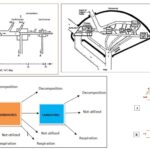Biochemistry 4 Views 1 Answers
Sourav PanLv 9April 18, 2025
what does the krebs cycle do
what does the krebs cycle do
Please login to save the post
Please login to submit an answer.
Sourav PanLv 9May 15, 2025
The Krebs cycle functions as the central metabolic hub of the cell, responsible for the oxidation of acetyl-CoA into carbon dioxide while capturing high-energy electrons in the form of NADH and FADH₂. These electron carriers fuel the electron transport chain for ATP production through oxidative phosphorylation. Additionally, the cycle generates GTP (or ATP) through substrate-level phosphorylation and provides intermediates for biosynthetic pathways, including amino acid, nucleotide, and heme synthesis. It integrates catabolic and anabolic processes, regulates energy production, and maintains metabolic homeostasis.
0
0 likes
- Share on Facebook
- Share on Twitter
- Share on LinkedIn
0 found this helpful out of 0 votes
Helpful: 0%
Helpful: 0%
Was this page helpful?




